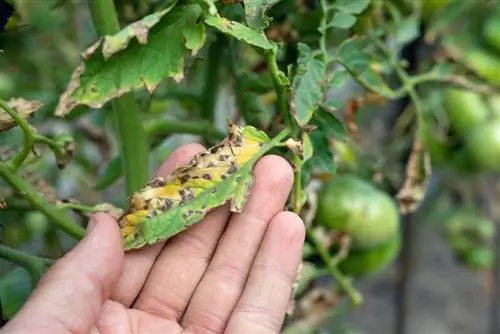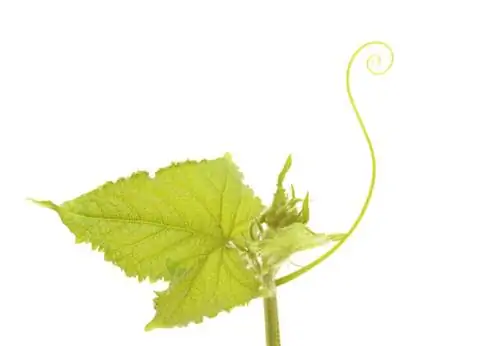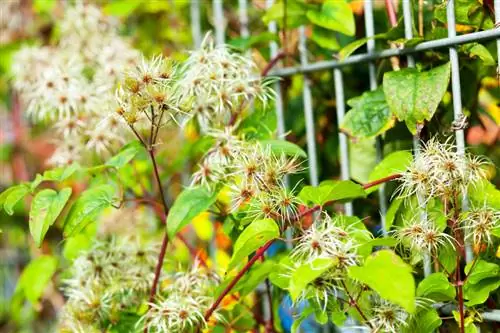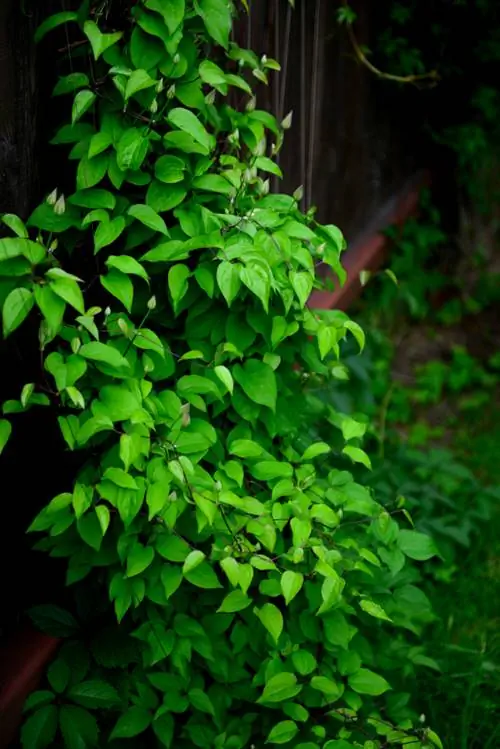- Author admin [email protected].
- Public 2023-12-16 16:46.
- Last modified 2025-10-04 22:19.
Are your tomato plants getting yellow leaves and wilting? These symptoms are usually caused by pests or deficiencies and are easy to treat.

Why do tomato plants get yellow leaves?
Yellow leaves on tomato plants can be caused by various factors such as lack of water, lack of nutrients, diseases or pests. To find out and treat the cause, you should check the location, nutrient supply and possible pest infestation.
What to do if tomato plants have yellow leaves?
Yellow leaves on tomatoes usually indicate a deficiency. This can consist of simple care errors such as too little fertilizer, inadequate water supply or an incorrect location. The most common diseases that cause yellow leaves are nitrogen deficiency, magnesium deficiency, late blight, over or under fertilization and lack of water. Ensure there is sufficient supply of water, fertilizer, light and air between the plants and leaves. Depending on the disease, remove affected parts or plants completely.
Yellow leaves due to too much water
Every hobby gardener probably comes to the point at some point where they have provided their tomato plants with too little or too much water. In most cases, the tomato forgives such small mistakes. But in the long run, incorrect watering causes lasting damage - up to and including complete failure of the harvest. ASign of improper water supply in both directions is yellow leaves. A thumb test is used to determine the moisture in the substrate.
If it is too dry, the initially yellow leaves will become limp and brown without any action until they finally fall off. If the soil feels moist, the leaves remain yellow. The yellow color is due to an inadequate supply of nutrients, as the roots rot due to too much water (waterlogging) or have too little water to transport nutrients. In addition to removing the yellow leaves and, if necessary, repotting potted plants, the following tools make it easier to provide tomatoes with regular and sufficient water.
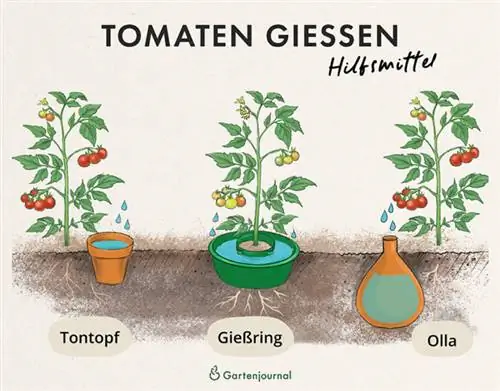
Clay pot with hole in the bottom: The inexpensive clay pot is buried in the ground next to the tomato plant. Water is then poured in from above. The irrigation water is released into the soil through the hole in the pot.
Watering ring: The tomato plant is surrounded by water, which seeps through to the roots in the right amount. At the same time, the casting ring, which costs 10 to 20 euros, offers natural protection against crawling predators such as snails.
Olla: With a capacity of 1 L to 6.5 L, one Olla covers the needs of several plants at the same time. The bucket is a little more expensive with a price range of 30 to 50 euros, but has a long service life.
Yellow leaves due to tomato diseases
If water is supplied regularly and in moderation, but the foliage still appears yellow, a tomato disease may be the cause of the discoloration. Leaf spot or bacterial wilt infection should be considered if leaves are yellow. If such a suspicion is confirmed, immediate action must be taken to ensure that fungal spores and bacteria are not transferred to other plants.

Leaf spot: Humid and warm climates cause leaf spot (Septoria lycopersici). Starting from the lowest leaves, the fungus spreads to the upper ones. An infestation is initially manifested by a yellow discoloration and small glassy spots of a grayish color with black dots. Find out about black spots on tomatoes. If only a few leaves are affected, the following measures can help:
- Remove and destroy infected leaves
- Spray with skimmed milk
- Protect from rain and splash water
- Ensure sufficient air circulation (e.g. stripping out)
If more than half of the plant is already suffering from the fungus, the tomato should be completely removed and, at best, burned. Diseased plant parts do not belong in the compost!
Also find out about brown spots on tomatoes.
Bacterial wilt: As the name suggests, bacterial wilt (Corynebacterium michiganense) is a bacterial disease. Yellowish discolored undersides of leaves and brown-yellow channels in the cross section of the shoots are signs of an infection. If the disease is left untreated, the leaves will turn brown and fall off. If an infestation is detected early, the gardener can do the following:
- Remove and destroy infected leaves
- Remove surface compost or mulch
- loose up the soil
- Apply fertilizer
If more than a third of the plant is infected, then it should be destroyed completely. The fruits may then no longer be consumed.
Yellow leaves due to pests
Sucking insects like to help themselves to the nutrient-rich leaves of the tomato. Weak specimens or plants in the greenhouse, where the living conditions are particularly favorable for pests, react to the withdrawal of nutrients by insects with yellow leaves. The whitefly and the thrips are the usual troublemakers in the tomato patch.
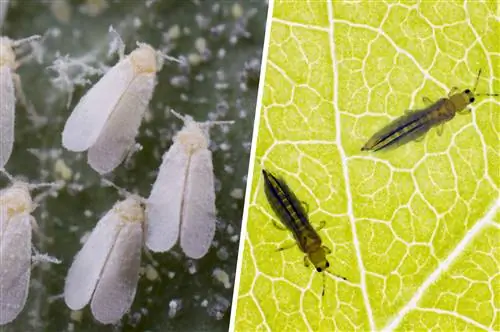
Left: whitefly, right: fringed wing fly (also thrips, thunderfly)
Whitefly: An infestation of whiteflies (Trialeurodes vaporariorum) is likely, especially in warm, humid summers. Individual insects do not cause any damage; But as soon as the tiny flies appear in swarms after touching the plant, action should be taken. Otherwise, the insects remove so many nutrients that the leaves are under-supplied and eventually turn yellow. Remedy:
- Narrow-meshed insect net (€10.00 on Amazon) in the open air
- Natural predators or beneficial insects (e.g. lacewings) in the greenhouse
- Attach yellow or glue boards nearby
Frenched-winged flies (thrisp, thunderfly): The black fringed-winged flies (Thysanoptera) attack the tomato in two ways. On the one hand, the larvae feed on the roots and on the other hand, the flying insects suck nutrients from the leaves. If the plant is severely infected, the leaves quickly turn yellow. Help against the fringed winged birds:
- Spray soft soap solution (500 ml of water with approx. 8 grams of soft soap) on the plant
- Distribute primary rock powder on the surface of the plant
- Natural predators or beneficial insects (predatory mites or hoverflies) in the greenhouse
Yellow leaves due to over- and under-supply of nutrients
If a faulty water supply, diseases and pests can be ruled out as the cause of yellow leaves on the tomato plant, a deficiency of an important plant nutrient must be the reason for the discoloration. This is usually preceded by very loamy or very sandy soil - the pH value should be around 6.5-7 for optimal supply.
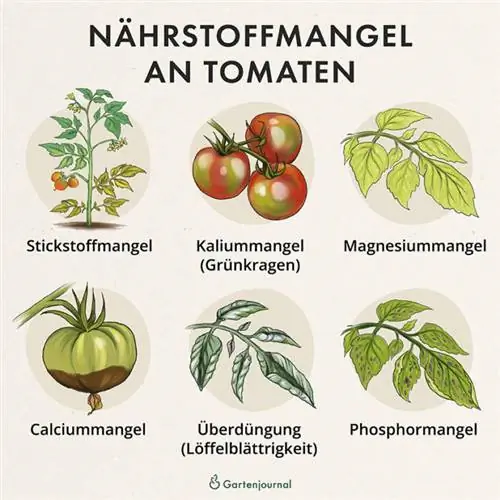
Nitrogen deficiency: If the roots absorb too little nitrogen, the lower leaves of the plant will turn yellow first. Growth stops until even the fresh, bright green of the young leaves gives way to a pale yellowish tone. Nitrogen can be incorporated into the soil organically or minerally to eliminate the deficiency.
Potassium deficiency/green collar: A potassium deficiency is most noticeable in the tomato fruits themselves: They remain green at the base of the stem. The leaves, on the other hand, turn yellow at the edges and dry out. There can be either too little potassium or too much nitrogen in the soil. As a result of the latter, the plant grows too quickly to supply itself with the available potassium.
Magnesium deficiency: If the leaves appear whitish-brown and only the leaf veins shimmer green, the plant is suffering from a magnesium deficiency. This situation is often due to soil that is too acidic. Inorganic fertilizer is the best solution here.
Calcium deficiency/blossom end rot: Calcium is important for building stable cell walls. If there is a lack of the mineral, the fruits begin to rot parallel to the base of the stem. Over time the leaves also become slightly yellowish. Correct watering and an alkaline soil, such as by adding primary rock powder, can balance the imbalance. If the tomato is too bushy, thinning out and general pruning can also help.
Overfertilization/Spoon-leaved: The tomato leaves do not turn yellow, but they become soft and rolled up if they receive too much nitrogen fertilizer. The plant grows too quickly to be supplied with other important nutrients. If the tomato is over-fertilized, suspend the next one or two fertilizations.
Phosphorus deficiency: If there is a phosphorus deficiency, the leaves become reddish-purple rather than yellow. Overall, the leaves are then rather smaller and dry out at the edges. This nutrient deficiency is rare and can be easily treated with organic fertilizer such as compost.
FAQ
Can I throw wilted or yellow leaves into the compost?
That depends on why the leaves are yellow. If the cause of the yellowing is due to a lack of nutrients, then yellow leaves can be disposed of in the compost. However, if illness or pests are the cause, they must be disposed of with household waste or, if permitted, burned.
Can the fruits of a tomato plant with yellow leaves be eaten?
The appearance of yellow leaves is particularly annoying when the harvest of lush tomatoes is approaching. With one exception, you can eat these safely. However, if the plant suffers from bacterial wilt, the fruits also become inedible and may no longer be consumed.
Why do tomatoes get yellow leaves?
The reason why tomatoes get yellow leaves is a lack of minerals that are necessary for the production of the green pigment chlorophyll. The cause of this is either incorrect water management, diseases, pests or an imbalance in the mineral balance.
Which pests are responsible for yellow leaves?
The black thrips and the whitefly feed on the plant juices of the tomato. The missing nutrients result in an undersupply in the leaves, which causes them to appear yellow.
What can I do about yellow leaves on tomato plants?
Basically, we recommend removing the yellow leaves immediately. The plant should then be examined more closely to see whether incorrect watering, a lack of nutrients, diseases or pests are responsible for the discoloration.

